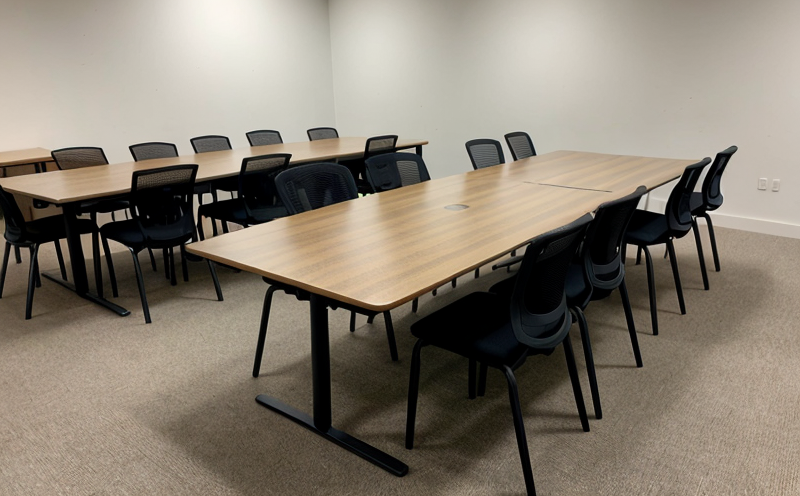BS EN 438 High Pressure Laminates Used for Table Surfaces Testing
The British Standard (BS) and European Norm (EN) 438 specifies the requirements, test methods, and quality control procedures for high-pressure laminates used in furniture manufacturing. This standard is particularly relevant to tables and desks where durability, aesthetic appeal, and safety are critical factors. High-pressure laminates, commonly known as HPLs, are composite materials made from a layer of paper impregnated with resin under heat and pressure.
These laminates offer excellent resistance to wear, chemical exposure, and abrasion, making them ideal for table surfaces in various settings such as offices, schools, retail spaces, and homes. The BS EN 438 standard ensures that manufacturers adhere to stringent quality control measures which guarantee consistent performance across all products.
Testing of these laminates according to BS EN 438 involves several key processes including visual inspection, thickness measurement, density testing, water absorption capacity assessment, flexural strength determination, and chemical resistance evaluation. Each test is designed to provide insights into the laminate's properties under different conditions that it might encounter in real-world use.
Visual inspections help identify any defects or inconsistencies immediately. Thickness measurements ensure compliance with specified tolerances ensuring uniformity across all products. Density tests measure how tightly packed the materials are within the laminates, affecting their overall strength and durability. Water absorption capacity assessments determine how well the laminate can resist moisture which is crucial for longevity in damp environments.
Flexural strength determinations assess how much force a laminate can withstand before breaking, providing essential information about its structural integrity. Lastly, chemical resistance evaluations check whether the laminate can endure exposure to various chemicals without degrading, ensuring suitability for specific applications like those involving food preparation areas or medical equipment.
The testing process also includes sample preparation which involves cutting out appropriate pieces from larger sheets of HPLs according to specified dimensions laid down by BS EN 438. This ensures that every test conducted is under controlled conditions replicating actual product usage scenarios as closely as possible.
Once the samples are prepared, they undergo rigorous testing using advanced equipment calibrated specifically for this purpose. Data from these tests are then analyzed meticulously to ensure compliance with all stipulated requirements outlined in BS EN 438. Compliance with these standards not only enhances consumer confidence but also helps manufacturers maintain their reputation as reliable suppliers.
In summary, the BS EN 438 standard provides a comprehensive framework for ensuring that high-pressure laminates used in table surfaces meet stringent quality criteria. By adhering to this standard during production and testing phases, furniture manufacturers can produce robust, long-lasting products that meet both regulatory requirements and customer expectations.
Scope and Methodology
| Test Item | Description |
|---|---|
| Visual Inspection | Check for any visible defects or inconsistencies in the laminate. |
| Thickness Measurement | Determine if the actual thickness of the sample matches the specified tolerance limits. |
| Density Testing | Evaluate how densely packed the materials are within the laminate, impacting its overall strength and durability. |
| Water Absorption Capacity Assessment | Assess how well the laminate resists moisture to ensure longevity in damp conditions. |
| Flexural Strength Determination | Measure the amount of force a laminate can withstand before breaking, indicating its structural integrity. |
| Chemical Resistance Evaluation | Determine whether the laminate can endure exposure to various chemicals without degrading. |
Industry Applications
- Offices: Durability and aesthetic appeal are paramount in office environments requiring robust furniture solutions.
- Schools: Safety and hygiene standards must be met, especially concerning food preparation areas or medical equipment.
- Retail Spaces: Attractive yet durable finishes enhance customer experience while ensuring longevity of display fixtures.
- Homes: Versatile usage within home settings where aesthetics, functionality, and ease of maintenance are key considerations.
Eurolab Advantages
At Eurolab, our commitment to excellence is reflected in every aspect of our testing services. Our state-of-the-art facilities equipped with the latest technology ensure precise and reliable results for your products. With years of experience in this field, we have built a reputation as leaders in providing accurate and timely reports.
We offer comprehensive support throughout the entire testing process from initial consultation to final report delivery. Our team of experts is dedicated to understanding your specific needs and tailoring our services accordingly. This approach ensures that you receive not just test results but valuable insights into how these results can be leveraged for improvement or compliance.
Our adherence to international standards like ISO, ASTM, EN, IEC, etc., guarantees that all tests conducted at Eurolab meet the highest quality benchmarks. By choosing us as your partner in testing services, you can rest assured knowing that your products will pass rigorous scrutiny and stand up well against competitive offerings.





